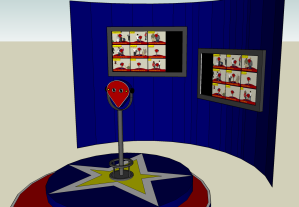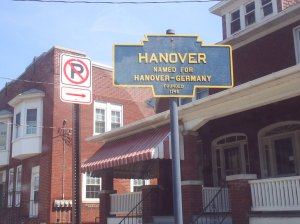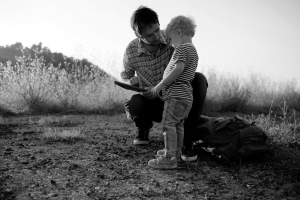 We’re in the USA Today’s Civil War Special Edition ,
We’re in the USA Today’s Civil War Special Edition ,
along with educator/bloggers Jim Beeghley, Eric Langhorst, and Angela Stokes from The Journey Through Hallowed Ground– a formidable trio!
We’ll also be presenting as a part of The Journey Through Hallowed Ground’s Annual Conference on May 25th!
Our Project in the USA Today
24 AprCivil War Alternate Reality Game for Students and the Public Beginning May 15th!
20 AprAs a part of our ongoing drive for support for our educational objectives with regard to augmented reality and the Civil War, we’ll be running an “alternate reality” game in support of the National Civil War Museum beginning May 15th.
The opportunity for is being offered, free, by the National Civil War Museum in Harrisburg, PA. The game, entitled “The Jewel of the Valleys,” is intended for students, classes, teachers, and the general public.
The game will revolve around a mysterious document discovered in the Museum’s vaults, and will prompt students to analyze primary documents, as well as introduce them to Civil War-era communications technology. The game involves the invasion of Pennsylvania in 1863, but also many of the larger issues and experiences of the war, so it fits well in many curricula, both PA and nationwide.
“The Jewel of the Valleys” will also coincide with, and intertwine with, Museum Curator Brett Kelley’s incredible march from Fredericksburg, VA to Harrisburg from May 16-30th as a Confederate soldier, following the track of General Ewell’s men as they invaded Pennsylvania in 1863. Kelley’s march will be followed by Hershey High School students in their blog at http://onthemarch.wordpress.com, offering constant updates, videos, and images of Brett’s handwritten journals during the march.
The march and the game are both part of a creative and exciting fundraiser for the Education Department of the National Civil War Museum.
How can you help, get involved, or just have fun?
-Share this post with anyone who may be interested in playing!
-Organize a team of students to participate through the “Jewel of the Valleys” wiki at http://jewelofthevalleys.wikispaces.com/, you can join the wiki, ask for a page just for your team, decorate it, follow the game, brag about achievements, collaborate, etc.
-Offer to students as an after school activity, “club” activity, bellringer, extra credit, or classroom competition.
-Play yourself!
The mysterious document will be revealed on May 15th through many outlets, including this blog and many others. On the conclusion of Brett’s march on May 30th, prizes and certificates will be announced for the following:
Best Middle School Individual Historian
Best Middle School Team
Best High School Individual Historian
Best High School Team
Despite the prizes, it will honestly be quite fun and educational, as updates and clues will be revealed along the way through various forms of media (including social media), leading the public toward the elusive “Jewel of the Valleys.” See attachments for a promo poster (a few clues in it!), and a snippet from the mysterious document.
To donate to the fundraiser– go to http://www.nationalcivilwarmuseum.org/index_1.php
or http://www.firstgiving.com/fundraiser/intheirfootsteps/In-Their-Footsteps-On-the-March-to-Pennsylvania
To follow Brett’s journey, subscribe to http://onthemarch.wordpress.com and/or follow @cwsoldier24_7 on Twitter
To see what Brett did last year (during two massive blizzards), go to http://civilwarsoldier247.wordpress.com/
Any questions at all? Comment or contact us!
Great Article about the Project on ReadWriteWeb!
21 FebAfter having an exciting conversation with Audrey Watters, a writer for ReadWriteWeb, we learned yesterday that a fantastic description of our objectives was published on the very popular blog. We also had the honor of being mentioned along side the veritable Civil War 150 Data Project. Thanks very much to Audrey!
We’re hoping that the article and our project spark interest among some of the tech hardware and network companies who are looking to promote products that would shine in the hands of the public experiencing our interactive AR applications (Motorola Xoom, Samsung Galaxy, Apple iPad2?). What better way to show a company’s dedication to education, public history, and the creation of interactive and instructionally valuable user experiences?
If, by chance, you’re new to our project, please subscribe to this blog, follow us on Twitter at @ACWAR_Project and/or @HistoriQuestLLC. You can also follow on Facebook at Civil War Augmented Reality Project page or our HistoriQuest page.
Our Coverage So Far..
13 AugI’ve been trying to keep an organized list of the reviews and critiques of our Project. I think I’ve finally got one together. Here is a record of our fame, organized by blog/media type:
Newspapers
Civil War Blogs
Education Technology Blogs
Teaching the Civil War with Technology
Museum Blogs
Augmented Reality Blogs
Challenge 6: The land ownership and zoning controversies in public history
7 AugHow can the Civil War Augmented Reality Project positively affect the protection and maintenance of historic locales?

We believe that public participation in projects that geographically locate sites, people, and events in real space will lead to a greater public appreciation of the value of public land and building ownership.
We feel that knowledge of the past is inherently linked to real, outdoor places. Augmented reality applications like ours will reinforce this connection. The public, we feel, will in turn be more proactive in the protection of historic places.
Challenge 5: The number of communities with ignored but valuable stories to tell
6 AugIn the realm of historic tourism and public history, not all sites are equal. Due to varying funding and location, some sites are visitor-rich, while many struggle to survive. We feel that this variance damages history education.
The public is led to believe that some historic narratives are more important than others, and that historic experiences are held in orbit around high-visitation areas and the often short-lived, singular historic events promoted by those areas.
We feel that responsibly designed augmented reality can serve as an equalizer. Once the world becomes the museum, the public is offered exciting and thought-provoking experiences throughout a region, and throughout time periods.
Gettysburg visitors can be drawn, through interactive personal stories, from the battlefield to the town. The general public will discover that the Civil War affected every city and town in Pennsylvania, and that the experiences of Pennsylvanians before, during, and after the conflict are valid history worthy of attention. If the values of historic sites become more equalized by the extension of historic experience into the outside world, the large number of struggling and underfunded historical institutions in Pennsylvania will directly benefit.
Challenge 4: The value of AR vs. actual public use
5 AugChallenge #4: The educational value of AR vs. the number of persons who would actually experience it
 If the vast majority of the public do not have smartphones and are not aware of the possibilities of an augmented reality experience at historic sites, how can we expect to produce applications that actually see use?
If the vast majority of the public do not have smartphones and are not aware of the possibilities of an augmented reality experience at historic sites, how can we expect to produce applications that actually see use?
Firstly, we don’t see our applications as existing just for smartphone owners and just for the younger “digital natives.” We strongly believe that the benefits of augmented reality are not to be restricted to students and technology early adopters. Our applications are meant to be fused as a natural part of the site to which they are attached. They will involve outdoor interactivity, but also require users to explore the indoor areas of sites through the use of coded “markers.” We also see the availability of hardware for use by visitors to be an important way to invite the general public to experience our applications.
Secondly, our Project has an outreach objective. The development and placement of augmented reality viewer installations will serve to publicize the Project’s applications, and lessen the technological anxieties of much of the general public. What better way to encourage the exploration of nearby historic sites- by letting people have a peek at the world museum?
Challenge 3: Physical activity is an integral part of learning
4 AugEducators understand the importance of the integration of physical activity in the learning experience. However, that activity was usually restricted to the classroom, playground, and gym. Physical activity can also be effective in increasing student achievement through traditional “academic” subjects.
We feel that the Civil War Augmented Reality Project promotes physical activity through the encouragement of movement from place to place, and also in interactive scenarios where the users race to meet a time limit or compete with other users.
Health experts also have encouraged such practices, and the outdoor spaces of the United States could be both gym, library, and museum. As we like to say, “Get off of the wire and into the world.”
Challenge 2: The internet has not really “knocked down the classroom walls”
3 AugHere is our latest daily discussion of the challenges that the Civil War Augmented Reality Project is designed to meet.
Challenge #2: The internet has not really “knocked down the classroom walls.”
When the technological revolution of the end of the 20th century brought the web to classrooms, excited educators like ourselves were transformed. Many of us believed that the connectivity to the rest of the world effectively  “knocked down” the walls of our classrooms. While the connected classroom was incredibly revolutionary, we don’t feel that the process has gone far enough.
“knocked down” the walls of our classrooms. While the connected classroom was incredibly revolutionary, we don’t feel that the process has gone far enough.
Connected classrooms, though important, have not inherently encouraged an exploration of the outside world. Power wires and desktop computers still hold up the classroom walls. We feel that the next technological step, the use of augmented reality in education, effectively will dissolve the walls. As our motto suggests, effective learning sometimes requires students and teachers to “get off of the wire and into the world.”
When the walls are gone, the world, in responsible hands, becomes the classroom. Not only the classroom, but also a museum and library with artifacts, documents, structures, and stories to explore. Rather than being organized by time period or the Dewey Decimal System, the new world museum will physically add the “place” to time and subject.
Meeting the Challenges of Education, Tech, and Public History
2 AugAfter meeting with a large number of educators, historians, Civil War enthusiasts, heritage tourism experts and others interested in supporting the Civil War Augmented Reality Project, we’ve realized that what makes our Project special is the way in which we’ve tailored our ideas to meet several specific challenges in education, technology, and public history. So, what are the challenges, and how does our Project meet them?
The challenges as we see them:
- Historic sites rarely offer real interactivity
- The internet has not really “knocked down the classroom walls”
- Physical activity is an integral part of learning
- The educational value of AR vs. the number of persons who would actually experience it
- The number of communities with ignored but valuable stories to tell
- The land ownership and zoning controversies in public history
We’ll be posting our strategy for meeting each of the challenges, one challenge per day this week. Here’s one for today..
 “1. Historic sites rarely offer real interactivity”
“1. Historic sites rarely offer real interactivity”
We love the way in which a large number of historic sites are trying to bring 21st century technology to their visitors’ experiences. However, we’re concerned about the use of the term “interactive” in describing many user experiences.
Many of these “interactive” activities involve electronic tours or a set of touchscreens where visitors choose the video clip they’d like to see. While electronic touring is certainly a part of the Civil War Augmented Reality Project, we see the real purpose of our Project to provide true interactivity. Visitors will be given a story about real people and given the ability to choose their way through the experience, and learning through the process the real story in comparison to the chosen story. What better way to understand the challenges met by past individuals, and how those individuals were a part of the grander narrative of a historic site?



